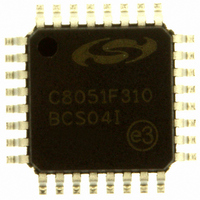C8051F310-GQ Silicon Laboratories Inc, C8051F310-GQ Datasheet - Page 137

C8051F310-GQ
Manufacturer Part Number
C8051F310-GQ
Description
IC 8051 MCU 16K FLASH 32LQFP
Manufacturer
Silicon Laboratories Inc
Series
C8051F31xr
Datasheets
1.C8051F310-TB.pdf
(228 pages)
2.C8051F310-TB.pdf
(2 pages)
3.C8051F310-GQ.pdf
(218 pages)
Specifications of C8051F310-GQ
Core Size
8-Bit
Program Memory Size
16KB (16K x 8)
Oscillator Type
Internal
Core Processor
8051
Speed
25MHz
Connectivity
SMBus (2-Wire/I²C), SPI, UART/USART
Peripherals
POR, PWM, Temp Sensor, WDT
Number Of I /o
29
Program Memory Type
FLASH
Ram Size
1.25K x 8
Voltage - Supply (vcc/vdd)
2.7 V ~ 3.6 V
Data Converters
A/D 21x10b
Operating Temperature
-40°C ~ 85°C
Package / Case
32-LQFP
No. Of I/o's
29
Ram Memory Size
1280Byte
Cpu Speed
25MHz
No. Of Timers
4
No. Of Pwm Channels
5
Digital Ic Case
RoHS Compliant
Rohs Compliant
Yes
Lead Free Status / RoHS Status
Lead free / RoHS Compliant
For Use With
770-1006 - ISP 4PORT FOR SILABS C8051F MCU336-1445 - ADAPTER PROGRAM TOOLSTICK F310336-1329 - KIT REF DESIGN SENSORLESS BLDC336-1253 - DEV KIT FOR C8051F310/F311
Eeprom Size
-
Lead Free Status / RoHS Status
Lead free / RoHS Compliant
Other names
336-1252
Available stocks
Company
Part Number
Manufacturer
Quantity
Price
Company:
Part Number:
C8051F310-GQ
Manufacturer:
SiliconL
Quantity:
4 998
Company:
Part Number:
C8051F310-GQ
Manufacturer:
SILICON
Quantity:
411
Company:
Part Number:
C8051F310-GQ
Manufacturer:
Silicon Laboratories Inc
Quantity:
10 000
Part Number:
C8051F310-GQ
Manufacturer:
SILICONLABS原装
Quantity:
20 000
Company:
Part Number:
C8051F310-GQR
Manufacturer:
SILICON
Quantity:
3 300
Company:
Part Number:
C8051F310-GQR
Manufacturer:
SILICON41
Quantity:
120
Company:
Part Number:
C8051F310-GQR
Manufacturer:
Silicon Laboratories Inc
Quantity:
10 000
Part Number:
C8051F310-GQR
Manufacturer:
SILICON LABS/芯科
Quantity:
20 000
C8051F310/1/2/3/4/5
14.3. SMBus Operation
Two types of data transfers are possible: data transfers from a master transmitter to an addressed slave
receiver (WRITE), and data transfers from an addressed slave transmitter to a master receiver (READ).
The master device initiates both types of data transfers and provides the serial clock pulses on SCL. The
SMBus interface may operate as a master or a slave, and multiple master devices on the same bus are
supported. If two or more masters attempt to initiate a data transfer simultaneously, an arbitration scheme
is employed with a single master always winning the arbitration. Note that it is not necessary to specify one
device as the Master in a system; any device who transmits a START and a slave address becomes the
master for the duration of that transfer.
A typical SMBus transaction consists of a START condition followed by an address byte (Bits7-1: 7-bit
slave address; Bit0: R/W direction bit), one or more bytes of data, and a STOP condition. Each byte that is
received (by a master or slave) must be acknowledged (ACK) with a low SDA during a high SCL (see
Figure 14.3). If the receiving device does not ACK, the transmitting device will read a NACK (not acknowl-
edge), which is a high SDA during a high SCL.
The direction bit (R/W) occupies the least-significant bit position of the address byte. The direction bit is set
to logic 1 to indicate a "READ" operation and cleared to logic 0 to indicate a "WRITE" operation.
All transactions are initiated by a master, with one or more addressed slave devices as the target. The
master generates the START condition and then transmits the slave address and direction bit. If the trans-
action is a WRITE operation from the master to the slave, the master transmits the data a byte at a time
waiting for an ACK from the slave at the end of each byte. For READ operations, the slave transmits the
data waiting for an ACK from the master at the end of each byte. At the end of the data transfer, the master
generates a STOP condition to terminate the transaction and free the bus. Figure 14.3 illustrates a typical
SMBus transaction.
SCL
SDA
SLA6
SLA5-0
R/W
D7
D6-0
START
Slave Address + R/W
ACK
Data Byte
NACK
STOP
Figure 14.3. SMBus Transaction
14.3.1. Arbitration
A master may start a transfer only if the bus is free. The bus is free after a STOP condition or after the SCL
and SDA lines remain high for a specified time (see
Section “14.3.4. SCL High (SMBus Free) Timeout”
on page
138). In the event that two or more devices attempt to begin a transfer at the same time, an arbi-
tration scheme is employed to force one master to give up the bus. The master devices continue transmit-
ting until one attempts a HIGH while the other transmits a LOW. Since the bus is open-drain, the bus will
be pulled LOW. The master attempting the HIGH will detect a LOW SDA and lose the arbitration. The win-
ning master continues its transmission without interruption; the losing master becomes a slave and
receives the rest of the transfer if addressed. This arbitration scheme is non-destructive: one device
always wins, and no data is lost.
Rev. 1.5
137











